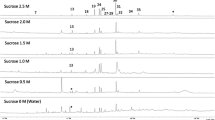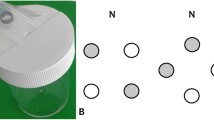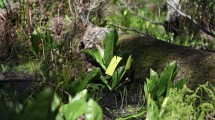Abstract
Foraging bumblebees can detect scents left on flowers by previous bumblebee visitors and hence avoid flowers that have been depleted of nectar. Tarsal secretions are probably responsible for this repellent effect. The chemical components of the tarsal glands were analyzed by combined gas chromatography–mass spectrometry for three species of bumblebee, Bombus terrestris, B. lapidarius, and B. pascuorum. The hydrocarbons identified were similar for each species, although there were interspecific differences in the relative amounts of each compound present. The tarsal extracts of all three species comprised complex mixtures of long-chain alkanes and alkenes with between 21 and 29 carbon atoms. When B. terrestris tarsal extracts were applied to flowers and offered to foraging bumblebees of the three species, each exhibited a similar response; concentrated solutions produced a repellent effect, which decreased as the concentration declined. We bioassayed synthetic tricosane (one of the compounds found in the tarsal extracts) at a range of doses to determine whether it gave a similar response. Doses ≥ 10−12 ng/flower resulted in rejection by foraging B. lapidarius. Only when ≤ 10−14 ng was applied did the repellent effect fade. We bioassayed four other synthetic compounds found in tarsal extracts and a mixture of all five compounds to determine which were important in inducing a repellent effect in B. lapidarius workers. All induced repellency but the strength of the response varied; heneicosane was most repellent while tricosene was least repellent. These findings are discussed in relation to previous studies that found that tarsal scent marks were attractive rather than repellent.
Similar content being viewed by others
REFERENCES
BergstrÈm, G., Svensson, B. G., Appelgren, M., and Groth, I. 1981. Complexity of bumblebee marking pheromones: biochemical, ecological and systematical interpretations, pp. 175–183, in P. E. Howse and J. L. Clement (eds.). Biosystematics of Social Insects, Academic Press, London.
Blum, M. S. 1981. Chemical Defenses of Arthropods. Academic Press, New York.
Blum, M. S. 1987. Specificity of pheromonal signals: a search for its recognitive bases in terms of a unified chemisociality, pp. 401–405, in J. Eder and H. Rembold (eds.). Chemistry and Biology of Social Insects. J. Peperny, MÜnchen.
Cameron, S. A. 1981. Chemical signals in bumblebee foraging. Behav. Ecol. Sociobiol. 9:257–260.
Corbet, S. A., Willmer, P. G., Beament, J. W. L., Unwin, D. M., and Prys-jones, O. E. 1979. Post-secretory determinants of sugar concentration in nectar. Plant Cell. Environ. 2:293–308.
Corbet, S. A., Kerslake, C. J. C., Brown, D., and Morland, N. E. 1984. Can bees select nectarrich flowers in a patch? J. Apic. Res. 23:234–242.
Crane, E. 1975. Honey: A Comprehensive Survey. Heinemann in cooperation with International Bee Research Association, London.
Crawley, M. J. 1991. GLIM for Ecologists. Blackwell, Oxford.
Duffield, G. E., Gibson, R. C., Gilhooly, P. M., Hesse, A. J., Inkley, C. R., Gilbert, F. S., and Barnard, C. J. 1993. Choice of flowers by foraging honey-bees (Apis mellifera)-possible morphological cues. Ecol. Entomol. 18:191–197.
Dukas, R., and Real, L. A. 1993. Effects of nectar variance on learning by bumblebees. Anim. Behav. 45:37–41.
Ferguson, A. W., and Free, J. B. 1979. Production of forage-marking pheromone by the honeybee. J. Apic. Res. 18:128–135.
Frankie, G., and Vinson, S. B. 1977. Scent-marking of passion flowers in Texas by females of Xylocopa virginica texana (Hym. Anthophoridae). J. Kans. Entomol. Soc. 50:613–625.
Free, J. B., and Williams, I. H. 1972. The role of the Nasanov gland pheromone in crop communication by honeybees (Apis mellifera L.). Behaviour 41:314–318.
Free, J. B., and Williams, I. H. 1983. Scent-marking of flowers by honeybees. J. Apic. Res. 18:128–135.
Free, J. B., Williams, I., Pickett, J. A., Ferguson, A. W., and Martin, A. P. 1982a. Attractiveness of (Z)-11-eicosen-1-ol to foraging honeybees. J. Apic. Res. 21:151–156.
Free, J. B., Ferguson, A. W., Pickett, J. A., and Williams, I. H. 1982b. Use of unpurified Nasonov pheromone components to attract clustering honeybees. J. Apic. Res. 21:26–29.
Giurfa, M. 1993. The repellent scent-mark of the honeybee Apis mellifera ligustica and its role as communication cue during foraging. Insect. Soc. 40:59–67.
Giurfa, M., and Núñez, J. A. 1992. Honeybees mark with scent and reject recently visited flowers. Oecologia 89:113–117.
Giurfa, M., Núñez, J. A., and Backhaus, W. 1994. Odour and colour information in the foraging choice behavior of the honeybee. J. Comp. Physiol. 175:773–779.
Goulson, D., Hawson, S. A., and Stout, J. C. 1998. Foraging bumblebees avoid flowers already visited by conspecifics or by other bumblebee species. Anim. Behav. 55:199–206.
Heinrich, B. 1979. Resource heterogeneity and patterns of movement in foraging bumblebees. Oecologia 40:235–245.
Holm, S. 1979. A simple sequentially rejective multiple test procedure. Scand. J. Stat. 6:65–70.
Kato, M. 1988. Bumble bee visits to Impatiens spp.: Pattern and efficiency. Oecologia 76:364–370.
Kevan, P. G. 1976. Fluorescent nectar (technical comment). Science 194:341–342.
Lockey, K. H. 1980. Insect cuticular hydrocarbons. Comp. Biochem. Physiol. 65B:457–462.
Marden, J. H. 1984. Remote perception of floral nectar by bumblebee. Oecologia 64:232–240.
Menzel, R., and MÜller, U. 1996. Learning and memory in honeybees: from behaviour to neural substrates. Annu. Rev. Neurosci. 19:379–404.
NÚÑez, J. A. 1967. Sammelbienen markieren versiegte Futterquellen durch Duft. Naturwissenschaften 54:322–323.
Oldham, N. J., Billen, J., and Morgan, E. D. 1994. On the similarity of Dufour gland secretion and their cuticular hydrocarbons of some bumblebees. Physiol. Entomol. 19:115–123.
Schmitt, U. 1990. Hydrocarbons in tarsal glands of Bombus terrestris. Experientia 46:1080–1082.
Schmitt, U., and Bertsch, A. 1990. Do foraging bumblebees scent-mark food sources and does it matter? Oecologia 82:137–144.
Schmitt, U., LÜbke, G., and Franke, W. 1991. Tarsal secretion marks food sources in bumblebees (Hymenoptera: Apidae). Chemoecology 2:35–40.
Stout, J. C., Goulson, D., and Allen, J. A. 1998. Repellent scent marking of flowers by a guild of foraging bumblebees (Bombus spp.). Behav. Ecol. Sociobiol. 43:317–326.
TengÖ, J., Hefetz, A., Bertsch, A., Schmitt, U., LÜbke, G., and Francke, W. 1991. Species specificity and complexity of Dufour's gland secretion of bumble bees. Comp. Biochem. Physiol. 99B:641–646.
Thorp, R. N., Briggs, D. L., Estes, J. R., and Erikson, E. H. 1975. Nectar fluorescence under ultraviolet irradiation. Science 189:476–478.
Thorp, R. N., Briggs, D. L., Estes, J. R., and Erikson, E. H. 1976. [Reply to Kevan (1976)]. Science 194:342.
Vallet, A., Cassier, P., and Lensky, Y. 1991. Ontogeny of the fine structure of the mandibular glands of the honeybee (Apis mellifera L.) workers and the pheromonal activity of 2-heptanone. J. Insect Physiol. 37:789–804.
Von Frisch, K. 1923. Ubie die “Sprache” der Beinen, eine tierpsychologische Untersuchung. Zool. Jahrb. Ab. All. Zool. Physiol. 40:1–186.
Wetherwax, P. B. 1986. Why do honeybees reject certain flowers? Oecologia 69:567–570.
Williams, A. A., Hollands, T. A., and Tucknott, O. G. 1981. The gas chromatographic-mass spectrometric examination of the volatiles produced by the fermentation of a sucrose solution. Z. Lebensm. Forsch. 172:377–381.
Williams, C. S. 1998. The identity of the previous visitor influences flower rejection by nectarcollecting bees. Anim. Behav. 56:673–681.
Zimmerman, M. 1982. Optimal foraging: random movement by pollen collecting bumblebees. Oecologia 53:394–398.
Author information
Authors and Affiliations
Rights and permissions
About this article
Cite this article
Goulson, D., Stout, J.C., Langley, J. et al. Identity and Function of Scent Marks Deposited by Foraging Bumblebees. J Chem Ecol 26, 2897–2911 (2000). https://doi.org/10.1023/A:1026406330348
Issue Date:
DOI: https://doi.org/10.1023/A:1026406330348




